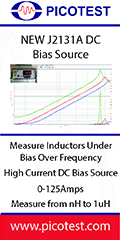 |
|
IN THIS ISSUE:
» Evaluating Fuses, Breakers, PTCs And Electronic Fuses For Automotive Applications
» A Quick Way To Determine Power Supply Output Resistance
» Configurable IC Enables Flexible And Efficient LED Lamp Driver
» Focus On Magnetics:
Determining Design Power Over An Input Voltage Range (Part 1): Maximum Inductor Power
» Spotlight On Safety & Compliance:
EMC+SIPI Talks Reveal More About EMI Filter Design For Flyback Converters
» New Power Products
» Other Top Power News
From the Editor's Desk David G. Morrison
Editor, HOW2POWER TODAY

Whatever effects the pandemic is having on the electronics industry, it doesn’t appear to be holding back the introduction of new power components. New SiC and GaN power semiconductors continue to be rolled out at a fast pace, as evidenced by the product stories in this newsletter. Although the wide-bandgap (WBG) transistors are prominent, a related product category is also generating more news lately—gate drivers. Some of these parts are standalone driver ICs or modules for SiC MOSFETs while others are chips co-packaged with GaN power devices. These gate drivers ease design-in of the WBG transistors, enable their better performance and provide power device protection. Additionally, we’ve seen new driver ICs to support silicon MOSFETs, some for specific applications such as motor drives or key markets such as automotive. While these announcements don’t usually generate much fanfare, these products signal the build-out of an ecosystem for WBG parts, and other efforts to optimize power conversion in popular applications. New gate drivers may not be revolutionary but they are important for the success of many high-performance power circuits. So look for more gate driver news in the year ahead. As with gate drivers, circuit protection devices don’t generate big headlines, but new options such as electronic fuses (eFuses) are helping designers achieve reliability with flexibility in industrial and automotive applications. A feature in this issue by Jerry Steele discusses what these devices have to offer in comparison with other circuit protection devices, while pondering how eFuses may evolve to provide even greater protection. Other articles here discuss a simple technique for measuring power supply output resistance, a flexible LED driver design, the concept of design power for inductors, EMI filter design for low power flybacks, and more.
|
|

 |
 |

|
HOW2POWER EXCLUSIVE DESIGN ARTICLES 
|
Evaluating Fuses, Breakers, PTCs And Electronic Fuses For Automotive Applications
by Jerry Steele, Red Hill Labs, Tucson, Ariz.
This article explains the differences between the popular circuit protection devices available to electronics designers including fuses, circuit breakers, PTCs and electronically assisted circuit breakers also known as electronic fuses or eFuses. Their tripping mechanisms and other characteristics such as isolation, accuracy, reset ability and programmability are discussed with an eye toward evaluating their flexibility and reliability, and helping designers to select the right device type for their applications. This article uses examples from industrial devices to illustrate the functionality that is needed for automotive applications and functional safety. It concludes by looking ahead to the next step in the evolution of electronic fuses—a device that can meet functional safety requirements.
Read the article…
|

An electronic breaker or eFuse can limit
current without actually opening the circuit,
offers programmability and features in trip
points, but lacks physical isolation. |

|

This method of determining power
supply output resistance is based on
measuring the voltage across the
nominal load and the voltage across
the load when an extra resistor is
connected in parallel. |
A Quick Way To Determine Power Supply Output Resistance
by Gregory Mirsky, Vitesco Technologies, A Spinoff Of Continental Automotive Systems, Deer Park, Ill.
When dealing with slow-changing dc loads, like solenoids, brushed motors, heaters, etc., it is necessary to rapidly define a power supply output resistance in order to correctly assess the power supply load capability and tweak the feedback loop if necessary. There are diverse methods for defining the output impedance of a power supply, but some of these methods involve test instruments that may not always be available and/or produce more information than is needed for the loads in question. This article presents a highly simplified method. It needs only a multimeter and a resistor of any resistance close to the load resistance.
Read the article…
|

Configurable IC Enables Flexible And Efficient LED Lamp Driver
by Serhiy Prykhodko, Dialog Semiconductor, Lviv, Ukraine
LEDs have high efficiency and brightness, which makes them the performance leaders in many lighting applications. However, the LED driver can also play a key role in the performance of these applications. Among the many LED driver ICs available to designers, a new, high-voltage version of Dialog Semiconductor’s GreenPAK configurable, mixed-signal matrix IC, the SLG47105, offers particular advantages when configured as an LED driver. This chip, which is also known as the HV PAK, enables a very compact driver design that is simultaneously very flexible and highly efficient. This article describes the configuration of the HV PAK as an LED driver with brightness and color temperature control.
Read the article…
|

The SLG47105 is configured as an
LED driver with four buttons to
control LED brightness and color
temperature. |


FOCUS ON MAGNETICS 
Sponsored by Payton Planar Magnetics
A monthly column presenting information on power magnetics design, products, or related technology |

Determining Design Power Over An Input Voltage Range (Part 1): Maximum Inductor Power
by Dennis Feucht, Innovatia Laboratories, Cayo, Belize
Designs are often rated based on a fixed input voltage, Vg but for many applications with a variable input voltage, the power requirements increase. This is typically the case with inductors and transformers used in power supply designs, and it results in oversizing or undersizing of these components. However, if the inductor and transformer transfer power are evaluated for a given PWM-switch configuration, it’s possible to specify the device’s power rating more accurately and better optimize component size. Yet, determining the magnetic component’s maximum power consumption alone is not quite sufficient for optimizing the power rating and therefore the device size. With that in mind, this article series introduces a new concept that the author refers to as design power, which is the product of the max current seen by the component across the voltage range and the maximum range voltage.
Read the full article…
|

 |
 |

SPOTLIGHT ON SAFETY & COMPLIANCE 
Sponsored by Power Integrations
A monthly column discussing standards and regulatory requirements affecting power electronics |

EMC+SIPI Talks Reveal More About EMI Filter Design For Flyback Converters
by Kevin Parmenter, Chair, and James Spangler, Co-chair, PSMA Safety and Compliance Committee
While many of the presentations at EMC+SIPI 2020 addressed EMI and EMC issues broadly, some of the talks had a power electronics focus. This article focuses on two such presentations on EMI filter design by Michael Schutten and Cong Li of GE Research. which offered practical information on filter design for low-power flyback converters. Not only were these talks interesting on their own, they also were similar to work that I (Jim) and my co-authors presented at the Power Electronics Technology conference in 2002. All of these talks explained and demonstrated how the various components used in an EMI filter affect the line-conducted noise. In this article, we’ll discuss and compare these presentations to highlight what power supply designers can learn from them.
Read the full article…
|

 |
 |

 |
|
|

 — POWER PRODUCTS IN 3 IMAGES OR LESS — POWER PRODUCTS IN 3 IMAGES OR LESS 
|


Power Integrations’ MinE-CAP
power IC. |
Power IC Shrinks Input Bulk Capacitor, Reduces Inrush Current
 Diagram: MinE-CAP offsets the need for large values of high-voltage capacitors by switching low-voltage capacitors into the power supply circuit at low line voltage, and then switching them out when the line voltage increases. Diagram: MinE-CAP offsets the need for large values of high-voltage capacitors by switching low-voltage capacitors into the power supply circuit at low line voltage, and then switching them out when the line voltage increases.
 Photo: In this example power supply design, the power IC replaces one 400-V 100-µF bulk capacitor with one 400-V 22-µF capacitor and two 160-V 47-µF capacitors. In addition to reducing the total volume of the capacitors required for bulk energy storage by 50%, this technique reduces inrush current and increases the total capacitance by 16%, enabling more peak power. Photo: In this example power supply design, the power IC replaces one 400-V 100-µF bulk capacitor with one 400-V 22-µF capacitor and two 160-V 47-µF capacitors. In addition to reducing the total volume of the capacitors required for bulk energy storage by 50%, this technique reduces inrush current and increases the total capacitance by 16%, enabling more peak power.
See the full story…
|


 |

|


Texas Instruments’ UCC5870-Q1
IGBT/SiC MOSFET gate driver. |
Isolated IGBT/SiC MOSFET Gate Driver Benefits HEV/EV Applications
 Diagram: The driver IC is a functional safety compliant, isolated, highly configurable single-channel gate driver targeted to drive high-power SiC MOSFETs and IGBTs in EV/HEV applications. It features integrated diagnostics and protection, supporting functional safety goals enabling ISO 26262 compliance up to ASIL D. Diagram: The driver IC is a functional safety compliant, isolated, highly configurable single-channel gate driver targeted to drive high-power SiC MOSFETs and IGBTs in EV/HEV applications. It features integrated diagnostics and protection, supporting functional safety goals enabling ISO 26262 compliance up to ASIL D.
 Diagram: Use of this gate driver can reduce board size by at least 50% to increase system-level power density in an EV traction inverter. Diagram: Use of this gate driver can reduce board size by at least 50% to increase system-level power density in an EV traction inverter.
See the full story…
|

Renesas Electronics’ ISL81801 and
ISL81802 dc-dc controllers. |
80-V DC-DC Controllers Provide Extra Voltage Margin For Data Center, Telecom Applications
 Photo: The bidirectional buck-boost (‘801) and dual buck (‘802) controllers are said to achieve the industry’s highest reliability performance, react quickly to transient loads with a minimum number of BOM components, and provide the extra voltage margin that 48-V telecom, data center and industrial applications demand. Photo: The bidirectional buck-boost (‘801) and dual buck (‘802) controllers are said to achieve the industry’s highest reliability performance, react quickly to transient loads with a minimum number of BOM components, and provide the extra voltage margin that 48-V telecom, data center and industrial applications demand.
See the full story…
|

 |

|

Tektronix’s TIVP series IsoVu
isolated oscilloscope probes. |
Isolated Oscilloscope Probes Offer Smaller Size And More Capabilities
 Photo: Like the first-generation probes, the IsoVu Gen 2 probes use patented electro-optical technologies to capture signals and power the probes without the need for an electrical connection to the oscilloscope. They offer a unique combination of high bandwidth, dynamic range and CMRR over the probe’s full bandwidth. But these second-gen IsoVu probes also offer greater robustness, higher bandwidth, smaller size and lower cost than their predecessors. Photo: Like the first-generation probes, the IsoVu Gen 2 probes use patented electro-optical technologies to capture signals and power the probes without the need for an electrical connection to the oscilloscope. They offer a unique combination of high bandwidth, dynamic range and CMRR over the probe’s full bandwidth. But these second-gen IsoVu probes also offer greater robustness, higher bandwidth, smaller size and lower cost than their predecessors.
See the full story…
|


|










|


 Power Integrations has announced that shipments of its InnoSwitch family of ICs have surpassed one billion units. These offline switcher ICs incorporate the company’s FluxLink communication technology and include GaN switches in the higher power models. Power Integrations has announced that shipments of its InnoSwitch family of ICs have surpassed one billion units. These offline switcher ICs incorporate the company’s FluxLink communication technology and include GaN switches in the higher power models.
Click here for more industry news...

ABOUT THIS NEWSLETTER: Thank you for reading HOW2POWER TODAY.
How2Power sends no more than one e-mail per month to registered users. Continuing your subscription ensures you'll receive future newsletters. Manage Your Subscription
©2020 All rights reserved. www.how2power.com
|
|